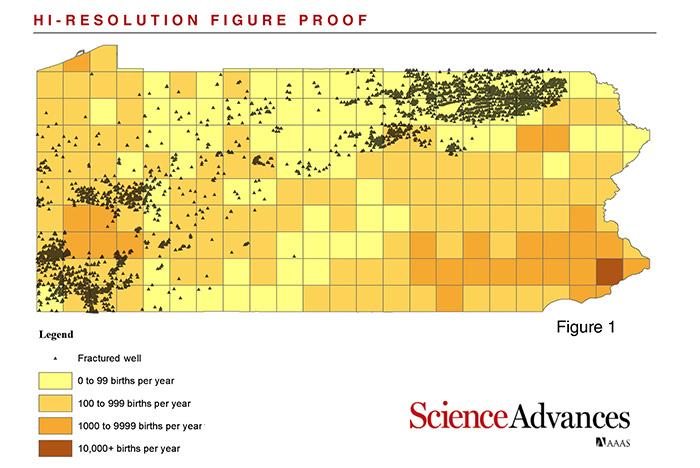From North Dakota to Ohio to Pennsylvania, hydraulic fracturing, also known as fracking, has transformed small towns into energy powerhouses. While some see the new energy boom as benefiting the local economy and decreasing U.S. reliance on foreign oil, others fear the potential health and environmental consequences that come along with fracking. Health risks increase for infants born to mothers living within 2 miles of a hydraulic fracturing site, according to a study published Dec. 13 in Science Advances. The research team found that infants born within a half a mile from a fracking site were 25 percent more likely to be born at low birth weights, leaving them at greater risk of infant mortality, ADHD, asthma, lower test scores, lower schooling attainment and lower lifetime earnings.
Health risks increase for infants born to mothers living within 2 miles of a hydraulic fracturing site, according to a study published Dec. 13 in Science Advances. The research team found that infants born within a half a mile from a fracking site were 25 percent more likely to be born at low birth weights, leaving them at greater risk of infant mortality, ADHD, asthma, lower test scores, lower schooling attainment and lower lifetime earnings.
“Given the growing evidence that pollution affects babies in utero, it should not be surprising that fracking, which is a heavy industrial activity, has negative effects on infants,” said co-author Janet M. Currie, the Henry Putnam Professor of Economics and Public Affairs at Princeton University.
“As local and state policymakers decide whether to allow hydraulic fracturing in their communities, it is crucial that they carefully examine the costs and benefits, including the potential impacts from pollution,” said study co-author Michael Greenstone, the Milton Friedman Professor in Economics and director of the Energy Policy Institute at the University of Chicago. “This study provides the strongest large-scale evidence of a link between the pollution that stems from hydraulic fracturing activities and our health, specifically the health of babies.”
Using records from more than 1.1 million births across Pennsylvania from 2004 to 2013, the researchers compared infants born to mothers living near a drilling site to those living farther away from a site, before and after fracking began at that site.
The most significant impacts were seen among babies born within .6 miles of a site, as those babies were 25 percent more likely to be low birth weight, that is born under 5.5 pounds.
Infants born to mothers living between half a mile and 2 miles saw their risk of low birth weight decrease by about a half to a third. Infants born to mothers living beyond 2 miles experienced little to no impact to their health. “These results suggest that hydraulic fracturing does have an impact on our health, though the good news is that this is only at a highly localized level,” said Currie, who directs the Center for Health and Wellbeing at Princeton’s Woodrow Wilson School of Public and International Affairs. “Out of the nearly 4 million babies born in the United States each year, about 29,000 of them are born within about a half mile of a fracking site.”
“These results suggest that hydraulic fracturing does have an impact on our health, though the good news is that this is only at a highly localized level,” said Currie, who directs the Center for Health and Wellbeing at Princeton’s Woodrow Wilson School of Public and International Affairs. “Out of the nearly 4 million babies born in the United States each year, about 29,000 of them are born within about a half mile of a fracking site.”
“While we know pollution from hydraulic fracturing impacts our health, we do not yet know where that pollution is coming from — from the air or water, from chemicals onsite, or an increase in traffic,” said co-author Katherine Meckel, assistant professor at the University of California, Los Angeles. “Until we can determine the source of this pollution and contain it, local lawmakers will be forced to continue to make the difficult decision of whether to allow fracking in order to boost their local economies — despite the health implications — or ban it altogether, missing out on the jobs and revenue it would bring.”
This study follows previous work by Currie, Greenstone and others on the local economic benefits, which found the average household living near a hydraulic fracturing site benefits by as much as $1,900 per year. This was because of a 7 percent increase in average income, driven by rises in wages and royalty payments, a 10 percent increase in employment, and a 6 percent increase in housing prices. However, the authors cautioned that the housing prices could change if further information about the environmental and health impacts of hydraulic fracturing were revealed.
“Housing prices are not fixed; they are based on many factors including how well the job market is and how safe the area is to live in,” Currie said. “As these results and others on the health impacts from hydraulic fracturing become mainstreamed into the consciousness of homeowners and home buyers, the local economic benefits could decrease.”
The study, “Hydraulic Fracturing and Infant Health: New Evidence from Pennsylvania,” first appeared online Dec. 13 in Science Advances.

